Pages 4 & 5 of Feb. 7, 2017 Long Branch Guidelines Draft focuses on 3.2 Height & Massing
Update:
A more complete and highly informative overview of the contents of the Feb. 7, 2017 Long Branch Urban Design Guidelines Draft Document is available at the website of Ward 6 Councillor Mark Grimes. We owe thanks to Councillor Grimes for the role that he and his office have played in the initiation and development of the Pilot Project.
Click here to access the overview at the Ward 6 Councillor’s website >
[End]
Focus Questions
As noted at a previous post, the Feb. 7, 2017 meeting of the Long Branch Guidelines Advisory Group addressed a series of Focus Questions, namely:
1. Do you have any suggested refinements to the Long Branch Character Framework Plan?
What do you like about the draft guidelines?
How could they be improved?
3.2 Height & Massing
3.3. Building Elements
3.4 Driveways & Garages
3.5 Setbacks & Landscapes
3.6 Special Features
3. Are there any additional guidelines we should consider?
4. Do you have any suggestions for the approach / format for the public meeting?
[End]
3.2 Height & Massing
I am posting each set of pages, roughly one set of pages per day, from the Long Branch Draft Reference Material (which are for discussion purposes only) that was distributed at the Feb. 7, 2017 meeting, and that will be available (if it’s not already posted) at the City of Toronto website.
Yesterday’s post was about 2.2, a Character Summary establishing the Long Branch Character Framework Plan. Today’s post focuses on 3.2 Height & Massing.
3.2.1 Building Heights
The Introduction to page 4 reads:
Throughout Long Branch, building heights vary in type from detached bungalows to four-storey walk-up apartments.
Buildings should comply with zoning permissions and be consistent in height with existing houses along the street and/or, through articulation of volumes and sensitivity to existing datums, should transition relative to adjacent conditions.
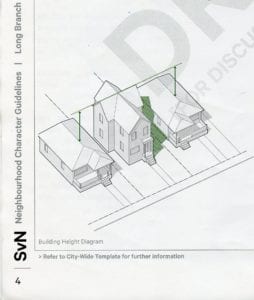
Building Height Diagram for Objectives: 3.2 Height & Massing. Note below image reads: Refer to City-Wide Template for further information. Source: Long Branch Draft (for discussion purposes only) Reference Material, Feb. 7, 2017, page 4 (detail)
Objectives
The text for Objectives for 3.2 Height & Massing reads:
- Volume: Maintain a similar scale between new and old buildings. The perceived scale of new buildings can be minimized by designing multiple smaller volumes or articulations to avoid a large, single mass. Common compatible elements are porches, stepbacks/balconies for upper levels, asymmetrical plans with setback, integration of upper levels within the roof, etc.;
- Access to natural daylight: Ensure that the building does not block neighbours’ access to natural daylight as much as possible, including on yards and main windows;
- Entrances: Minimize the appearance of stairs to entrances, in order to decrease the perceived height, through additional elements (e.g. plantings) or integrate it well into the overall front facade (e.g. low-wall, porch). [Refer to Section 2.3.2 Front Entrance Design.]
*
Click on each image to enlarge it; click again to enlarge it further
*
Page 4 features the following additional text:
*
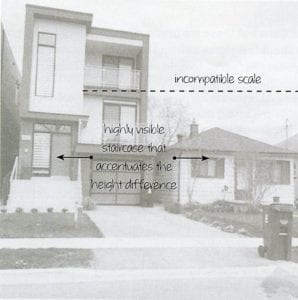
Figure 44. Modern house dwarfs existing 1-storey bungalow. Source: Long Branch Draft (f0r discussion purposes only) Reference Material, Feb. 7, 2017, page 5
How does the zoning regulate building heights?
Building heights in Long Branch vary from 1 to 3.5 storeys with the exception of a few isolated apartment blocks that are generally setback generously from the street and fronting on larger open spaces.
The predominant zoning regulation sets a maximum building height of 9.5m (see section 1.3.2 for more detail) and encompasses much of the neighbourhood’s RD zones.
In the RM Zones which permit a variety of residential building types, the max. building height varies between 10-12m.
In addition to height, the zoning regulates a ratio of main walls that can achieve the max. building height.
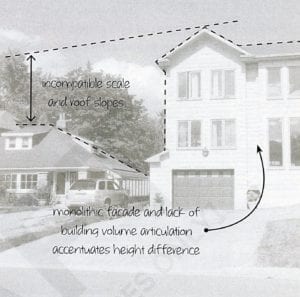
Figure 45. Incompatible building volumes accentuate height difference. Source: Long Branch Draft (f0r discussion purposes only) Reference Material, Feb. 7, 2017, page 5
What is the zoning’s intent?
The intent is to ensure that new development fit an appropriate scale with the existing built form through the integration of taller forms into sloped roof massing (e.g. dormers) or in the case of flat roofs through stepbacks.
Particular importance should be placed on evaluating building height compatibility based on relationships to adjacent properties in order to mitigate issues related to overshadowing and privacy/overlook.
What are the key design guidelines?
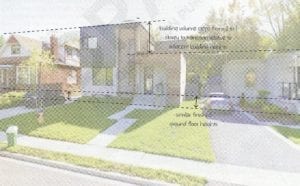
Figure 46. New development transitions height in relation to adjacent buildings, Source: Long Branch Draft (f0r discussion purposes only) Reference Material, Feb. 7, 2017, page 5
In order to achieve the objectives related to volume, access to daylight and entrances in the context of Long Branch key design guidelines include:
- Stepbacks of taller forms and/or articulation of building massing through the use of projections and/or recesses to achieve a transition in height relative to adjacent buildings
- The use of building elements such as porches, canopies, overhangs and well integrated stairs/plantings to mitigate the percieved height and massing and create alignments with existing datums of the streetwall
A note at the page bottom reads:
See Character Defining Conditions > a. and f.
Please note: I have broken longer paragraphs into shorter ones, for ease in online reading.

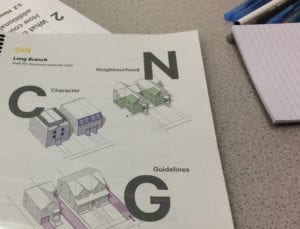
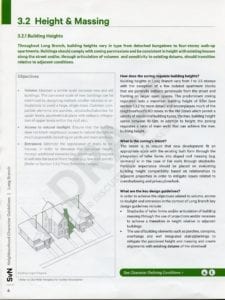
Leave a Reply
Want to join the discussion?Feel free to contribute!